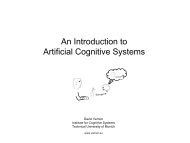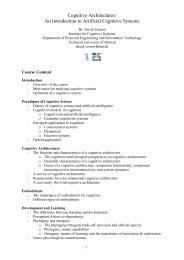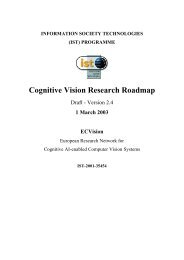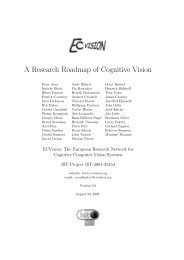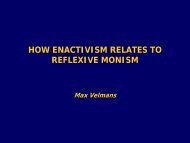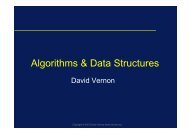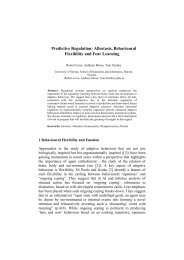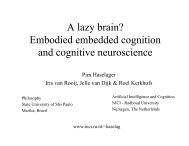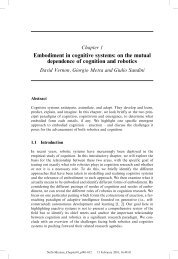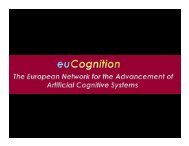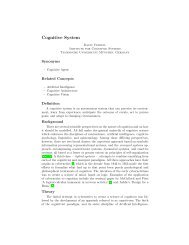Dynamic Field Theory (DFT): Applications in Cognitive Science and ...
Dynamic Field Theory (DFT): Applications in Cognitive Science and ...
Dynamic Field Theory (DFT): Applications in Cognitive Science and ...
Create successful ePaper yourself
Turn your PDF publications into a flip-book with our unique Google optimized e-Paper software.
An example on the perceptual level is the <strong>in</strong>teractive learn<strong>in</strong>g of labels for<br />
different objects that are manipulated <strong>in</strong> jo<strong>in</strong>t action tasks [36]. The dynamic field<br />
architecture consists of various coupled two-dimensional feature label fields that get<br />
<strong>in</strong>put from the camera system. Object features like colour, shape <strong>and</strong> size represent one<br />
dimension of a field whereas the object label is represented along the second dimension.<br />
The output of all label feature fields is <strong>in</strong>tegrated <strong>in</strong> a decision layer that conta<strong>in</strong>s one<br />
node for each label. There exist lateral connections between the feature label fields that<br />
ensure that dur<strong>in</strong>g the recognition process the same labels belong<strong>in</strong>g to different<br />
features fields excite each other. Feedback connections from the output field, on the<br />
other h<strong>and</strong>, guarantee that activation peaks <strong>in</strong> the feature label fields that do not match<br />
the decision <strong>in</strong> the output field are ext<strong>in</strong>guished. Dur<strong>in</strong>g the supervised tra<strong>in</strong><strong>in</strong>g phase, a<br />
correct label is given to the robot if recognition fails. Learn<strong>in</strong>g with<strong>in</strong> the distributed<br />
network takes place <strong>in</strong> form of a buildup of preshape (or memory trace) at positions<br />
where a peak has emerged dur<strong>in</strong>g successful recognition trials.<br />
The <strong>DFT</strong> model of action underst<strong>and</strong><strong>in</strong>g has been <strong>in</strong>tegrated <strong>in</strong> control<br />
architectures to endow robots with the capacity of goal-directed imitation ([5], [37]). It<br />
has been validated <strong>in</strong> the context of grasp<strong>in</strong>g-plac<strong>in</strong>g sequences. The def<strong>in</strong><strong>in</strong>g feature of<br />
the three-layer field architecture is a learned mapp<strong>in</strong>g from motor primitives <strong>in</strong> the<br />
action observation layer onto motor primitives <strong>in</strong> the action execution layer. It<br />
implements a match<strong>in</strong>g on the goal <strong>and</strong> not on the movement level. The architecture can<br />
thus cope with differences <strong>in</strong> embodiment, task constra<strong>in</strong>ts <strong>and</strong> motor skills between<br />
teacher <strong>and</strong> robot. A self-stabilized activation peak represent<strong>in</strong>g a certa<strong>in</strong> goal biases the<br />
decision process <strong>in</strong> the action execution layer toward the selection of motor primitives<br />
that can be used by the robot to achieve that goal. Moreover, the existence of goaldirected<br />
action cha<strong>in</strong>s <strong>in</strong> the middle layer of the field architecture allows the robot to act<br />
on a goal that it has to <strong>in</strong>fer s<strong>in</strong>ce the end state of the sequence was hidden from view or<br />
the user accidently failed to place the object at the desired location. If the mean<strong>in</strong>g of an<br />
action is understood, further knowledge may be transferred from an experienced teacher<br />
to the robot <strong>in</strong> imitation paradigms. For <strong>in</strong>stance, knowledge where o place a certa<strong>in</strong><br />
class of objects (e.g., def<strong>in</strong>ed by colour or shape) may be acquired <strong>and</strong> will be<br />
represented <strong>in</strong> learned synaptic l<strong>in</strong>ks between neural populations encod<strong>in</strong>g the goal <strong>and</strong><br />
specific object features.<br />
For cooperative jo<strong>in</strong>t tasks, imitat<strong>in</strong>g the human behaviour is normally not<br />
beneficial for the robot <strong>and</strong> the team. The <strong>in</strong>terpretation of observed actions <strong>in</strong> terms of<br />
goals should lead to the selection of an appropriate complementary behaviour. Both<br />
processes, goal <strong>in</strong>ference <strong>and</strong> the action selection, depend on the situational context. A<br />
dynamic field architecture that establishes a context dependent mapp<strong>in</strong>g from observed<br />
actions onto complementary actions has been recently developed <strong>and</strong> tested <strong>in</strong> a task <strong>in</strong><br />
which a robot <strong>and</strong> a human jo<strong>in</strong>tly construct a toy robot [38]. The state of the<br />
construction that def<strong>in</strong>es which sub-goals are currently available for the team is<br />
represented by neural populations <strong>in</strong> the common sub-goal layer (CSGL) of the field<br />
architecture. If the <strong>in</strong>put from this layer <strong>and</strong> from the <strong>in</strong>tention layer (IL) represent<strong>in</strong>g<br />
the <strong>in</strong>ferred goal of the partner converge on the representation of a particular action<br />
sequence <strong>in</strong> the action execution layer (AEL), this action sequence will normally w<strong>in</strong><br />
the competition process between all possible actions. If a mismatch between the<br />
<strong>in</strong>ferred goal <strong>and</strong> the possible sub-goals exist, the robot is able to detect this error s<strong>in</strong>ce<br />
an activation peak <strong>in</strong> the error monitor<strong>in</strong>g layer (EML) will automatically appear. A<br />
selection of communicative gestures like po<strong>in</strong>t<strong>in</strong>g to ‘expla<strong>in</strong>’ the error to the human<br />
partner may then constitute an appropriate complementary behaviour. Interest<strong>in</strong>gly, how<br />
social the robot behaves can be controlled by a simple adaptation of the synaptic





